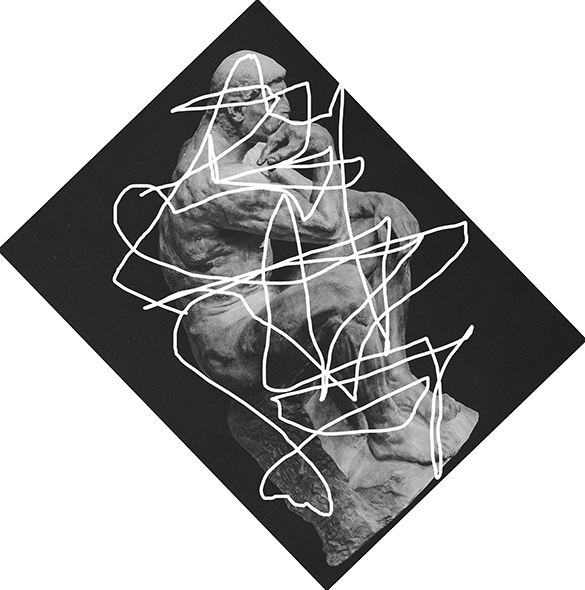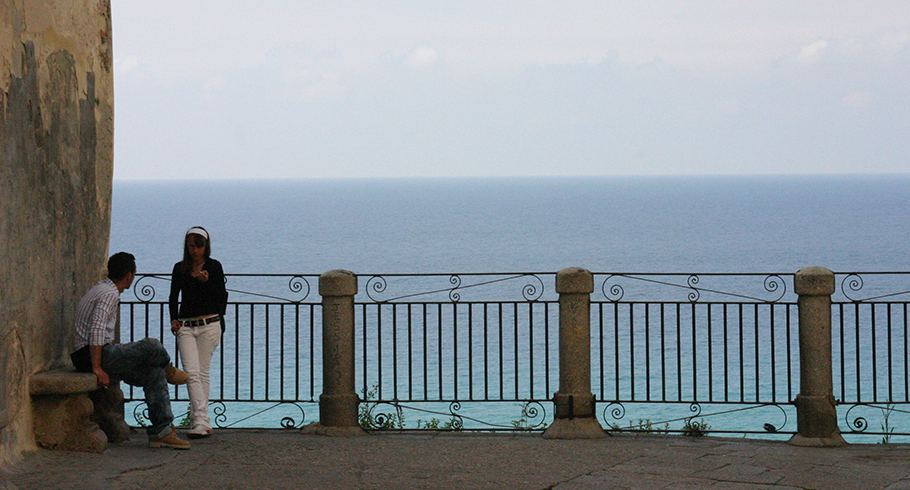THE GERMANWINGS DISASTER
Suicide. Or was it?
On March 24, 2015, an Airbus A320 of the company Germanwings crashed into the French Alps. Before long ‘everyone’ seemed to know why: the co-pilot had decided to end his life and downed the aircraft on purpose, while shutting the captain of the plane out of the cockpit.
That ‘knowledge’ was as reassuring as it was frightening. People want to know why an accident has happened, but if the conclusion turns out to be that the death wish of a person can be fatal for all passengers while he is flying ‘our’ plane, then we are concerned.

(‘The Thinker’ by Rodin, retrieved from copper thieves).
But was that conclusion accurate? Some time ago I met, fittingly in an aeroplane, an expert on flight safety. We discussed a whole range of topics, that I later reported on in a blogpost on this site.
To my surprise the expert proved not be in the least convinced of the suicide scenario concerning the Germanwings disaster. On the contrary.
The relevant, translated bit of the blogpost:
Striking: E doesn’t believe at all that the accident was caused on purpose by the co-pilot.
At the time of the crash the co-pilot was alone in the cockpit, with his headphones on.
E: ‘Than you don’t hear that someone is banging on the door’.
E knows someone who heard the audio recording in the cockpit and doesn’t believe that to be compatible with someone who is in the process of deliberately crashing his plane. Stressless breathing included.
I counter: ‘Since you describe Boeing as ‘German’, in the sense of thoroughly reliable, than it can also be envisaged that a German pilot intent on killing himself prepares for that act immaculately, for instance by taking beta blockers or other medication that will keep him calm’.
E sticks to his position all the same. Although the co-pilot had personal problems, at the time of the crash his prospects couldn’t be reconciled with a kamikaze action.
E rather thinks that the co-pilot, in simple words, pushed the right button at the wrong moment. More precisely, that he prepared the landing while unwillingly and unnoticed actually starting that landing procedure too early.
The subject kept haunting me. I spoke with two former captains of large commercial aircraft and asked their opinion. Those, I then put to The Expert.
He, in turn, interlaced the view of Captain A with his comments (in blue) and added them to the opinion of Captain B.
N.B.
‘Air-flight man’, a special subspecies of homo sapiens, tends to use a lot of jargon and abbreviations. If needed, see the glossary below.
The Opinions
A
‘The suicide motive still seems to me to be the most plausible cause. Because, if not, what else could it have been? I see only three possible alternatives:
1. Pilot incapacitation. In that case it must have happened at a moment when the co-pilot sat in such a posture that loss of conscience had him sagged onto the side stick (the steering unit at the right of him), causing the autopilot to disconnect. That in turn would have caused a so-called ‘aural warning’, that should have been audible also for someone on the other side of the door of the cockpit. I can envisage that the locked-out captain – in an attempt to find out what was going on inside the cockpit – at a certain point must have held his ear against the door so that he could have heard the aural warning.
‘I know the A320 well and the voice recorder (by the way, there are four recording channels in the cockpit) should have picked up this signal. Besides, the aural warning of disconnecting the autopilot of an A320 can be heard easily heard inside the cabin until seat row Four’.
2. ‘Erroneous pre-programming’ (dixit expert E).
That doesn’t seem probable to me.
‘The Mont Sainte Odile accident (January 20, 1992) proved not only that it is probable, but that it has happened’.
Pushing the right button at the wrong moment (long before the descent you start to prepare for landing), while you are not descending yet (as the captain was still outside of the cockpit), gives one ample time to correct that, even if the plane suddenly begins to dive unwanted.
Remedy: simply disconnect the automated mode and return the plane to the original height manually. I myself have flown only the A310, but that must be possible with the A320 as well, no doubt. Subsequently not opting for that remedy implies intent (read: a suicide scenario).
Moreover: as the only remaining pilot in the cockpit beginning to do anything that has nothing to do with the actual flight phase, is something that I don’t think the SOP’s (Standard Operating Procedures) of Germanwings can propagate. Doing just that also leads one to suspect intent.
‘A simple fact refutes this easily. At many companies the FMS (Flight Management System, the computer system that contains the flight plan data and transmits that to the autopilot when it is activated) is (re)programmed during the flight if a change occurs, or is expected’.
3. A technical failure so drastic that the co-pilot wasn’t able to correct it.
In the absence of the other pilot I would think that a remaining pilot who is fully conscious will at least make an attempt to get the captain back inside/alarm him.
‘I agree. But such a scenario is unfeasible for anyone without showing any sign of excitement, which was completely absent on the recordings’.
To my mind the ‘circumstantial evidence’ concerning the suicide scenario is stronger than any other scenario. At the most, it could be objected that it is strange that it happened on the return flight. Why not already on the outgoing flight?
‘We know that the Egyptair suicide (October 31, 1999) also took place during the return flight. But in my view that is completely unrelated. A suicidal person seeks the opportunity, not an outgoing or return flight. And circumstantial evidence has caused already many innocent people to languish in jail. (I had wanted to write ’too many people’, but even one innocent person in jail is one too many).
In the case of a flight accident, the only things that counts are facts, facts and facts. Circumstantials are no facts’.
I think we’ll never know.
Nonetheless, there is doubtless more to say about this highly remarkable case and therefore I will trade, as is fitting, my opinion willingly for another one.
As regards Mr.E: a spot-on description, that qualification of Airbus (in fact my – Joost’s – wording, condensing what E told me: ‘Airbus is a construction fault in itself’).
Whatever its beauty, intuitively I have always found Airbus to be more ‘complicated’ than all the Boeing types I have flown. That already began when our group of four, in Seattle for the B747-400 course, was picked up by a Boeing shuttle at the hotel and the driver cried out to us while we got in:
“Right, guys! If it ain’t Boeing I’m not going!”
*
B
If you ask my opinion concerning this accident, I can only reply with the restriction that I have too little information to state my ideas with firmness. Despite that I cautiously attempt to offer you my view.
In the first place, I consider the way in which the political and aviation authorities quickly and resolutely shared the reason for this accident to be both remarkable and reprehensible. As you probably know, protocol in the aviation sector demands that everyone refrains from premature statements or suggestions. Of course, journalists and ‘bachelor’s wives’ sin against this, but fortunately researchers and relevant parties in general abide by it.
Not so in this case. I am not fond of conspiracy theories. In this case, though, I find it striking that France came up with cues very quickly. They have a big interest in the reputation of Airbus (like the Germans, by the way) and are always eager to clear the Airbus product technically of any blame.
The same was to be observed concerning the AF447 accident over the Atlantic. The French state spent millions of euros of taxpayer’s money with no other objective than to clear Airbus of blame. After all, the first indications were that there may have been problems with the signalling in the cockpit, a known defect in that system present in a number of Airbus types. Moreover, it appeared that the control of the data that are continuously sent from aircraft to central computers, was inadequate. (The same, unfortunately, was the case with MH370).
Until this day it is maintained that it was the AF447-crew that failed, which I don’t contend, but in my opinion this conclusion was arrived at prematurely.
The reason for me not to believe that the FO acted deliberately, is that during the conversations with crew members that day there had not been the slightest indication of the FO brooding on any nefarious plan. He was friendly and open, something I cannot imagine in case you walk around with such a plan inside your head.
Also, in the time span after the CP left the cockpit up to the crash, there is not one single indication that this young man sent the plane into the mountain on purpose. Not a sound, no speeding up in breathing, no actions other than the reproved landing procedure that was possibly erroneously selected. After that input it was completely calm in the cockpit. Nothing that suggested panic nor heightened tension in the FO. I invite you to try to look at the ground that you are about to hit for minutes, without making a sound, without accelerated breathing. He didn’t react to warnings of automated systems that are installed in the aircraft nor to repeated calls via radio. Even more, he didn’t react at all to the undoubtedly loud banging on the cockpit door, the calling via intercom and the repeatedly keying-in of the door code. I suspect that this young man for some reason lost consciousness.
The fact that the FO had received help from a psychologist/psychiatrist for some time is a weak explanation, according to me. I suspect that a substantial number of the worldwide population of commercial (and military) pilots has received help, or even still receives it.
Of course, I also share the statements of A. Only, I don’t think, based on human factors, that the FO crashed the plane deliberately. If I am wrong, then I ascertain that this young man with a reputation of friendliness and professionalism must truly have been an incredibly coolheaded human being.
Again, I am not sufficiently informed. I suspect that there were other interests in play that pushed the investigation in a certain direction. After all, if the minister and the director have already pronounced statements in the media, it gets tricky for ‘simple’ researchers in the field to contradict them. Especially in France.
The speed with which the European aviation authorities now implement show measures – strikingly not followed by the American colleagues of the FAA – strengthens me in this opinion. EASA (and EU) has been proven more than once to be a vehicle of politically opportune measures and is surely on the leash of Airbus Industries.
There is nothing I can prove. Technically it seems action with intent, but from a perspective of human factors it seems to me irreconcilable with what we know of Andreas Lubitz’.
*
E:
‘I can only join this view fully. Especially the observation that the French authorities shared the reason for this accident quickly and resolutely, which is completely against the rules of ICAO Annex 13. (ICAO Annex 13 is internationally accepted (also by France) as the guideline for investigations of aviation accidents, with as its prime objective the prevention of such accidents in the future. ICAO Annex 13 is explicitly not meant to establish guilt).
In addition to B’s plea it is probably interesting to know that in France an aviation accident is a felony, for which guilt must be established and punished. That is why the investigation in principle is in the hands of the judicial authorities (police). (As was what happened after the Air Inter accident at Mont Sainte Odile, which clearly was due to the pilot’s error, but who died as a result. The technical director of Airbus (Mr. Bernard ZIEGLER) was then punished, even though he had already retired, as the representative of Airbus, by verdict of the tribunal in November 2007. By the way, he never served his time, but then, that is France.)
This is completely different in the US and The Netherlands, where an accident is not a felony, unless there are other indications that such is the case.
In short, I stick to my view, in accordance with B’s plea, that it is highly unlikely that the Germanwings disaster was caused by a suicide.
(Besides, B is not alone in his view concerning the ‘connection’ between EASA and Airbus)’.
Later Addition by E:
‘Last week I discussed the case again with a well-informed contact, leading us to a possible other scenario: that Andreas Lubitz simply fell asleep. The inspiration for this hypothesis came when I recently flew a plane myself and watched my co-pilot dozing off.
Considering Lubitz’ quiet breathing it is feasible that in this way he exerted just a slight pressure on the sidestick. Not enough to activate an aural warning, but just enough to get the plane into a gradual descent’.
B reacts:
‘Toxic cabin/cockpit air?’
(also coined as ‘aerotoxic syndrome’)
I react: ‘And/or because of other chemical substances?
Reaction from Italy, in short:
‘A bank director, who lives near us, wakes up with a headache; has breakfast with his wife; gets into his car; hits another car; the other driver taps on the window of the ‘offender’; the ‘offender’ stares into the void; drives on; hits three road workers; thereby killing one of them; drives on; parks his car next to his office; begins to work. The man, not under the influence of alcohol or drugs, has no idea why the police shows up’.
(After neurological tests, including brain scans, the ‘offender’ was dismissed of all charges).

Conclusion?
At least there is doubt about something that was already archived by many as a fact.
*
I’m sorry: the blogpost that started all this is in Dutch:
196. Vliegveiligheid
as is the one that accompanies this article: 255. Vliegvaria
*
Glossary
AF447 = Air France Airbus A330-203 / Rio de Janeiro-Paris / June 1, 2009
MH370 = Malaysia Airlines Boeing 777-200ER / Kuala Lumpur-Beijing / March 8, 2014
FO = First Officer – Co-pilot
CP = Chief Pilot/Commanding Pilot = PIC – Pilot-in-Command – Captain
FAA = Federal Aviation Administration
EASA = European Aviation Safety Agency
ICAO = International Civil Aviation Organization
Andreas Lubitz = the co-pilot of the disaster flight.
*
© Joost Overhoff

